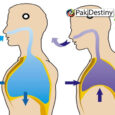
By Col Wajid Hussain
A rhythmic breath is silent, regular and through the nose. To bring air down into the depths of the lungs, it is not actually necessary to take a big breath, as even the quietest of breaths will activate the diaphragm which serves as our main breathing muscle When you are practicing abdominal nasal breathing, you should not be able to see or hear your breath during rest. In contrast, overbreathing through the mouth, in an attempt to take a “deep” breath, will be clearly audible and cause the chest to rise and fall, but will still not manage to draw the breath deeply into the lungs.
The Diaphragm
The diaphragm serves as our main breathing muscle for deep and efficient breathing. It is a dome-shaped sheet of muscle that separates the thorax (which houses the heart and lungs) from the abdomen (which houses the intestines, stomach, liver, and kidneys). The diaphragm lifts during exhalations, which shrinks the lungs, then it drops back down to expand them during inhalations. This up-and-down movement occurs within us some 50,000 times a day.
Poor breathing habits do not take full advantage of the diaphragm and in fact mostly over breathing is from the upper chest. In such a scenario, a typical adult engages as little as 10 percent of the range of the diaphragm, which overburdens the heart, elevates blood pressure, and causes a rash of circulatory problems. Taking rhythmic breath through nose utilizes 50 to 70 percent of the diaphragm’s capacity This will ease cardiovascular stress and allow the body to work more efficiently. The rule of thumb is that the diaphragm is located about four buttons down on your shirt. – Pak Destiny







